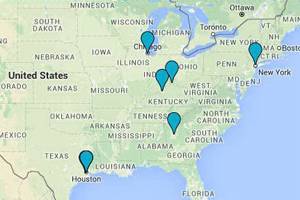Senior Reporter
Atlanta Tops ATRI List of Worst Truck Choke Points

The nation’s worst truck bottleneck is located in Atlanta, where a five-level stack interchange known as “Spaghetti Junction” joins Interstates 285 and 85 north, according to a new American Transportation Research Institute truck congestion survey.
The Atlanta interchange jumped two spots in the truck top ten list, surpassing last year’s top spot in Fort Lee, N.J., where Interstate 95 and state Road 4 merge just west of Manhattan’s George Washington Bridge.
The No. 2 worst bottleneck in this year’s survey is Chicago’s Circle Interchange at I-290 and I-90/I-94.
The Fort Lee bottleneck dropped to third worst on this year’s list.
Atlanta raced to the top of the list due to a late blooming economic turnaround, bad weather episodes, an increasing number of construction work zones, and a federal restart provision that dumped more trucks on the road during peak daylight hours, Dan Murray, ATRI’s vice president of research, told Transport Topics.
This year four of the top ten congested truck locations were in Houston, compared to only two in last year’s survey. The increase is largely the result of the city’s booming economy and population growth, Murray said.
FULL REPORT: Order here from www.atri-online.org
ATRI’s 2015 “Congestion Impact Analysis of Freight-Significant Highway Locations,” which assessed the level of truck-oriented congestion at 250 locations on the national highway system during 2014, used several customized software applications and analysis methods, along with terabytes of data from trucking operations to produce a ranking for each location.
ATRI survey samples come from GPS data onboard roughly 600,000 trucks across the U.S., Murray said.
ATRI said the data is associated with the FHWA-sponsored Freight Performance Measures initiative. The locations listed in the new ATRI report include the top 100 congested locations.
Louisville, Kentucky’s I-65 at I-64/I-71 ranked No. 4 on the list and Houston’s I-610 at US 290 and I-10 at I-45 were 5th and 6th worst.
The Nos. 7-10 most congested choke points were I-71 at I-75 in Cincinnati; I-45 at US 59 in Houston; SR 60 at SR 57 in Los Angles and I-10 at US 59 in Houston.
St. Louis’ I-70 and I-64 west interchange and Austin’s I-35 corridor fell off this year’s top ten list.
“With a robust economy comes increased demand for consumer goods, the lion's share of which is carried by truck,” Ed Crowell, Georgia Motor Trucking Association President and CEO, said in a statement. "ATRI's ranking allows states to better understand where targeted infrastructure improvements could keep the economy moving."
Murray said this year’s survey shows that congestion is worsening and average speeds in the large majority of the bottleneck locations is slowing significantly.
“We know that across the whole system that trucks are slowing down more and more,” Murray said. “Mostly we think that’s a function of a strong economy.”
For example, the average speed in the Atlanta interchange dropped to 39 mph from 42 mph last year, and at peak times went to 27 mph from 30 mph.
Murray said the Federal Motor Carrier Safety Administration’s hours-of-service restart provision that went into effect from July 2013 to December 2014 also played a role in the peak and non-peak hours truck bottlenecks.
“The movement from the 34-hour restart of trucks from driving at night, clearly had an impact as we saw the shift in truck GPS from nighttime to daytime,” Murray said. “There were 10% more trucks on the road during peak morning and afternoon times than last year.”
Murray also attributed the increase in congestion and delays to a rise in the number of construction zones as some states step up their road and bridge funding levels.
“Clearly we’re seeing a lot of states raise the fuel tax,” Murray said.

